CMI 301 Principles of Management and Leadership Assessment Booklet
VerifiedAdded on 2023/02/13
|19
|7083
|54
Homework Assignment
AI Summary
This document presents a completed assessment booklet for the CMI 301 Principles of Management and Leadership unit. The assessment covers key aspects of organizational governance, including explanations of Sole Trader, Partnership, and Limited Company structures. It also explores factors influencing organizational culture, such as company organization, strategy, mission, vision, and values. The assignment provides detailed insights into how these elements shape a company and its operations, emphasizing the importance of aligning strategy, mission, vision, and values to achieve business profitability. The assessment also highlights how these factors influence customer perception and decision-making, particularly in the post-COVID era, where customers are more critical when choosing companies and products. The document demonstrates an understanding of the CMI assessment criteria and indicative content, providing a comprehensive overview of management and leadership principles.
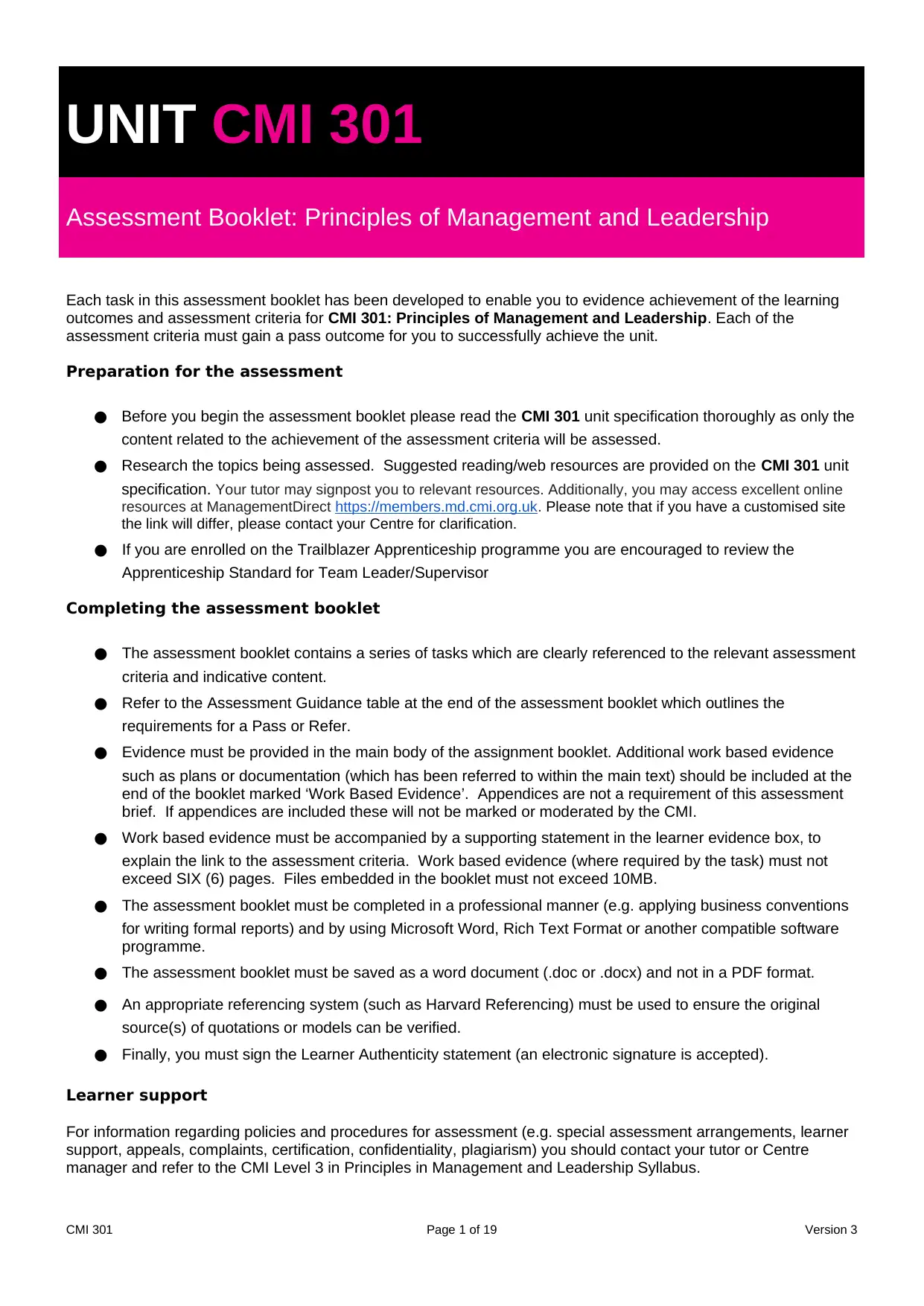
UNIT CMI 301
Assessment Booklet: Principles of Management and Leadership
Each task in this assessment booklet has been developed to enable you to evidence achievement of the learning
outcomes and assessment criteria for CMI 301: Principles of Management and Leadership. Each of the
assessment criteria must gain a pass outcome for you to successfully achieve the unit.
Preparation for the assessment
● Before you begin the assessment booklet please read the CMI 301 unit specification thoroughly as only the
content related to the achievement of the assessment criteria will be assessed.
● Research the topics being assessed. Suggested reading/web resources are provided on the CMI 301 unit
specification. Your tutor may signpost you to relevant resources. Additionally, you may access excellent online
resources at ManagementDirect https://members.md.cmi.org.uk. Please note that if you have a customised site
the link will differ, please contact your Centre for clarification.
● If you are enrolled on the Trailblazer Apprenticeship programme you are encouraged to review the
Apprenticeship Standard for Team Leader/Supervisor
Completing the assessment booklet
● The assessment booklet contains a series of tasks which are clearly referenced to the relevant assessment
criteria and indicative content.
● Refer to the Assessment Guidance table at the end of the assessment booklet which outlines the
requirements for a Pass or Refer.
● Evidence must be provided in the main body of the assignment booklet. Additional work based evidence
such as plans or documentation (which has been referred to within the main text) should be included at the
end of the booklet marked ‘Work Based Evidence’. Appendices are not a requirement of this assessment
brief. If appendices are included these will not be marked or moderated by the CMI.
● Work based evidence must be accompanied by a supporting statement in the learner evidence box, to
explain the link to the assessment criteria. Work based evidence (where required by the task) must not
exceed SIX (6) pages. Files embedded in the booklet must not exceed 10MB.
● The assessment booklet must be completed in a professional manner (e.g. applying business conventions
for writing formal reports) and by using Microsoft Word, Rich Text Format or another compatible software
programme.
● The assessment booklet must be saved as a word document (.doc or .docx) and not in a PDF format.
● An appropriate referencing system (such as Harvard Referencing) must be used to ensure the original
source(s) of quotations or models can be verified.
● Finally, you must sign the Learner Authenticity statement (an electronic signature is accepted).
Learner support
For information regarding policies and procedures for assessment (e.g. special assessment arrangements, learner
support, appeals, complaints, certification, confidentiality, plagiarism) you should contact your tutor or Centre
manager and refer to the CMI Level 3 in Principles in Management and Leadership Syllabus.
CMI 301 Page 1 of 19 Version 3
Assessment Booklet: Principles of Management and Leadership
Each task in this assessment booklet has been developed to enable you to evidence achievement of the learning
outcomes and assessment criteria for CMI 301: Principles of Management and Leadership. Each of the
assessment criteria must gain a pass outcome for you to successfully achieve the unit.
Preparation for the assessment
● Before you begin the assessment booklet please read the CMI 301 unit specification thoroughly as only the
content related to the achievement of the assessment criteria will be assessed.
● Research the topics being assessed. Suggested reading/web resources are provided on the CMI 301 unit
specification. Your tutor may signpost you to relevant resources. Additionally, you may access excellent online
resources at ManagementDirect https://members.md.cmi.org.uk. Please note that if you have a customised site
the link will differ, please contact your Centre for clarification.
● If you are enrolled on the Trailblazer Apprenticeship programme you are encouraged to review the
Apprenticeship Standard for Team Leader/Supervisor
Completing the assessment booklet
● The assessment booklet contains a series of tasks which are clearly referenced to the relevant assessment
criteria and indicative content.
● Refer to the Assessment Guidance table at the end of the assessment booklet which outlines the
requirements for a Pass or Refer.
● Evidence must be provided in the main body of the assignment booklet. Additional work based evidence
such as plans or documentation (which has been referred to within the main text) should be included at the
end of the booklet marked ‘Work Based Evidence’. Appendices are not a requirement of this assessment
brief. If appendices are included these will not be marked or moderated by the CMI.
● Work based evidence must be accompanied by a supporting statement in the learner evidence box, to
explain the link to the assessment criteria. Work based evidence (where required by the task) must not
exceed SIX (6) pages. Files embedded in the booklet must not exceed 10MB.
● The assessment booklet must be completed in a professional manner (e.g. applying business conventions
for writing formal reports) and by using Microsoft Word, Rich Text Format or another compatible software
programme.
● The assessment booklet must be saved as a word document (.doc or .docx) and not in a PDF format.
● An appropriate referencing system (such as Harvard Referencing) must be used to ensure the original
source(s) of quotations or models can be verified.
● Finally, you must sign the Learner Authenticity statement (an electronic signature is accepted).
Learner support
For information regarding policies and procedures for assessment (e.g. special assessment arrangements, learner
support, appeals, complaints, certification, confidentiality, plagiarism) you should contact your tutor or Centre
manager and refer to the CMI Level 3 in Principles in Management and Leadership Syllabus.
CMI 301 Page 1 of 19 Version 3
Paraphrase This Document
Need a fresh take? Get an instant paraphrase of this document with our AI Paraphraser
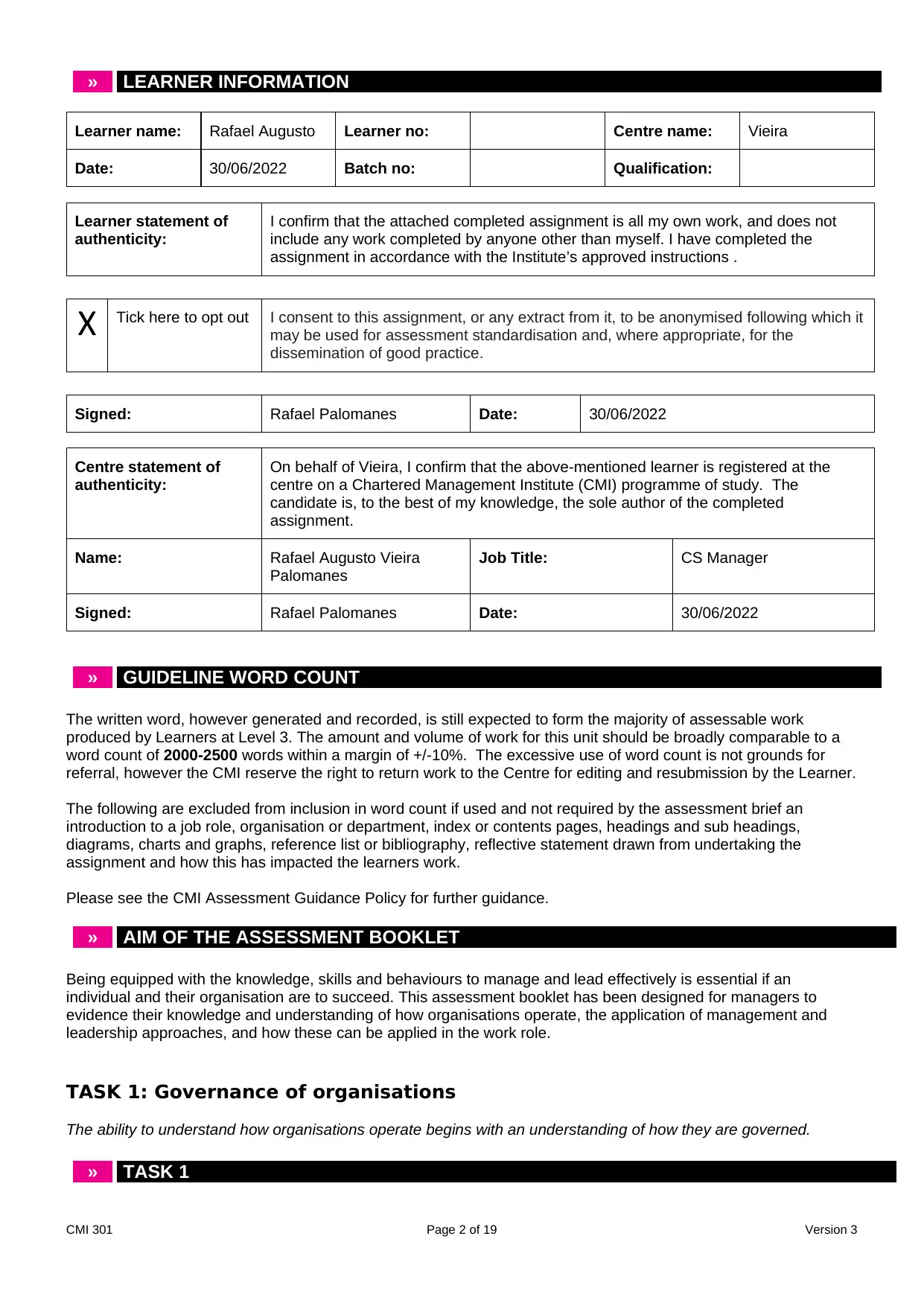
» LEARNER INFORMATION
Learner name: Rafael Augusto Learner no: Centre name: Vieira
Date: 30/06/2022 Batch no: Qualification:
Learner statement of
authenticity:
I confirm that the attached completed assignment is all my own work, and does not
include any work completed by anyone other than myself. I have completed the
assignment in accordance with the Institute’s approved instructions .
X Tick here to opt out I consent to this assignment, or any extract from it, to be anonymised following which it
may be used for assessment standardisation and, where appropriate, for the
dissemination of good practice.
Signed: Rafael Palomanes Date: 30/06/2022
Centre statement of
authenticity:
On behalf of Vieira, I confirm that the above-mentioned learner is registered at the
centre on a Chartered Management Institute (CMI) programme of study. The
candidate is, to the best of my knowledge, the sole author of the completed
assignment.
Name: Rafael Augusto Vieira
Palomanes
Job Title: CS Manager
Signed: Rafael Palomanes Date: 30/06/2022
» GUIDELINE WORD COUNT
The written word, however generated and recorded, is still expected to form the majority of assessable work
produced by Learners at Level 3. The amount and volume of work for this unit should be broadly comparable to a
word count of 2000-2500 words within a margin of +/-10%. The excessive use of word count is not grounds for
referral, however the CMI reserve the right to return work to the Centre for editing and resubmission by the Learner.
The following are excluded from inclusion in word count if used and not required by the assessment brief an
introduction to a job role, organisation or department, index or contents pages, headings and sub headings,
diagrams, charts and graphs, reference list or bibliography, reflective statement drawn from undertaking the
assignment and how this has impacted the learners work.
Please see the CMI Assessment Guidance Policy for further guidance.
» AIM OF THE ASSESSMENT BOOKLET
Being equipped with the knowledge, skills and behaviours to manage and lead effectively is essential if an
individual and their organisation are to succeed. This assessment booklet has been designed for managers to
evidence their knowledge and understanding of how organisations operate, the application of management and
leadership approaches, and how these can be applied in the work role.
TASK 1: Governance of organisations
The ability to understand how organisations operate begins with an understanding of how they are governed.
» TASK 1
CMI 301 Page 2 of 19 Version 3
Learner name: Rafael Augusto Learner no: Centre name: Vieira
Date: 30/06/2022 Batch no: Qualification:
Learner statement of
authenticity:
I confirm that the attached completed assignment is all my own work, and does not
include any work completed by anyone other than myself. I have completed the
assignment in accordance with the Institute’s approved instructions .
X Tick here to opt out I consent to this assignment, or any extract from it, to be anonymised following which it
may be used for assessment standardisation and, where appropriate, for the
dissemination of good practice.
Signed: Rafael Palomanes Date: 30/06/2022
Centre statement of
authenticity:
On behalf of Vieira, I confirm that the above-mentioned learner is registered at the
centre on a Chartered Management Institute (CMI) programme of study. The
candidate is, to the best of my knowledge, the sole author of the completed
assignment.
Name: Rafael Augusto Vieira
Palomanes
Job Title: CS Manager
Signed: Rafael Palomanes Date: 30/06/2022
» GUIDELINE WORD COUNT
The written word, however generated and recorded, is still expected to form the majority of assessable work
produced by Learners at Level 3. The amount and volume of work for this unit should be broadly comparable to a
word count of 2000-2500 words within a margin of +/-10%. The excessive use of word count is not grounds for
referral, however the CMI reserve the right to return work to the Centre for editing and resubmission by the Learner.
The following are excluded from inclusion in word count if used and not required by the assessment brief an
introduction to a job role, organisation or department, index or contents pages, headings and sub headings,
diagrams, charts and graphs, reference list or bibliography, reflective statement drawn from undertaking the
assignment and how this has impacted the learners work.
Please see the CMI Assessment Guidance Policy for further guidance.
» AIM OF THE ASSESSMENT BOOKLET
Being equipped with the knowledge, skills and behaviours to manage and lead effectively is essential if an
individual and their organisation are to succeed. This assessment booklet has been designed for managers to
evidence their knowledge and understanding of how organisations operate, the application of management and
leadership approaches, and how these can be applied in the work role.
TASK 1: Governance of organisations
The ability to understand how organisations operate begins with an understanding of how they are governed.
» TASK 1
CMI 301 Page 2 of 19 Version 3
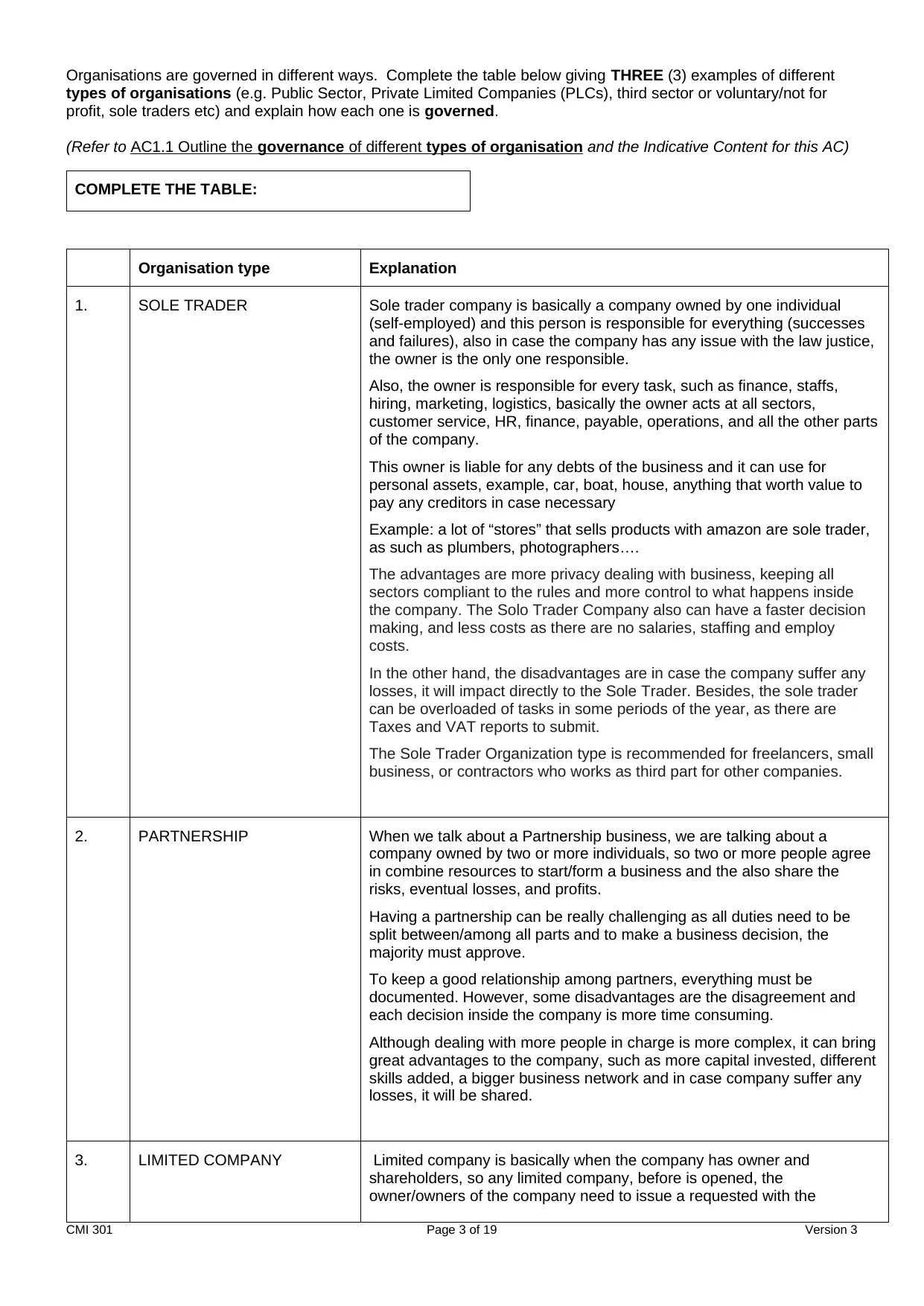
Organisations are governed in different ways. Complete the table below giving THREE (3) examples of different
types of organisations (e.g. Public Sector, Private Limited Companies (PLCs), third sector or voluntary/not for
profit, sole traders etc) and explain how each one is governed.
(Refer to AC1.1 Outline the governance of different types of organisation and the Indicative Content for this AC)
COMPLETE THE TABLE:
Organisation type Explanation
1. SOLE TRADER Sole trader company is basically a company owned by one individual
(self-employed) and this person is responsible for everything (successes
and failures), also in case the company has any issue with the law justice,
the owner is the only one responsible.
Also, the owner is responsible for every task, such as finance, staffs,
hiring, marketing, logistics, basically the owner acts at all sectors,
customer service, HR, finance, payable, operations, and all the other parts
of the company.
This owner is liable for any debts of the business and it can use for
personal assets, example, car, boat, house, anything that worth value to
pay any creditors in case necessary
Example: a lot of “stores” that sells products with amazon are sole trader,
as such as plumbers, photographers….
The advantages are more privacy dealing with business, keeping all
sectors compliant to the rules and more control to what happens inside
the company. The Solo Trader Company also can have a faster decision
making, and less costs as there are no salaries, staffing and employ
costs.
In the other hand, the disadvantages are in case the company suffer any
losses, it will impact directly to the Sole Trader. Besides, the sole trader
can be overloaded of tasks in some periods of the year, as there are
Taxes and VAT reports to submit.
The Sole Trader Organization type is recommended for freelancers, small
business, or contractors who works as third part for other companies.
2. PARTNERSHIP When we talk about a Partnership business, we are talking about a
company owned by two or more individuals, so two or more people agree
in combine resources to start/form a business and the also share the
risks, eventual losses, and profits.
Having a partnership can be really challenging as all duties need to be
split between/among all parts and to make a business decision, the
majority must approve.
To keep a good relationship among partners, everything must be
documented. However, some disadvantages are the disagreement and
each decision inside the company is more time consuming.
Although dealing with more people in charge is more complex, it can bring
great advantages to the company, such as more capital invested, different
skills added, a bigger business network and in case company suffer any
losses, it will be shared.
3. LIMITED COMPANY Limited company is basically when the company has owner and
shareholders, so any limited company, before is opened, the
owner/owners of the company need to issue a requested with the
CMI 301 Page 3 of 19 Version 3
types of organisations (e.g. Public Sector, Private Limited Companies (PLCs), third sector or voluntary/not for
profit, sole traders etc) and explain how each one is governed.
(Refer to AC1.1 Outline the governance of different types of organisation and the Indicative Content for this AC)
COMPLETE THE TABLE:
Organisation type Explanation
1. SOLE TRADER Sole trader company is basically a company owned by one individual
(self-employed) and this person is responsible for everything (successes
and failures), also in case the company has any issue with the law justice,
the owner is the only one responsible.
Also, the owner is responsible for every task, such as finance, staffs,
hiring, marketing, logistics, basically the owner acts at all sectors,
customer service, HR, finance, payable, operations, and all the other parts
of the company.
This owner is liable for any debts of the business and it can use for
personal assets, example, car, boat, house, anything that worth value to
pay any creditors in case necessary
Example: a lot of “stores” that sells products with amazon are sole trader,
as such as plumbers, photographers….
The advantages are more privacy dealing with business, keeping all
sectors compliant to the rules and more control to what happens inside
the company. The Solo Trader Company also can have a faster decision
making, and less costs as there are no salaries, staffing and employ
costs.
In the other hand, the disadvantages are in case the company suffer any
losses, it will impact directly to the Sole Trader. Besides, the sole trader
can be overloaded of tasks in some periods of the year, as there are
Taxes and VAT reports to submit.
The Sole Trader Organization type is recommended for freelancers, small
business, or contractors who works as third part for other companies.
2. PARTNERSHIP When we talk about a Partnership business, we are talking about a
company owned by two or more individuals, so two or more people agree
in combine resources to start/form a business and the also share the
risks, eventual losses, and profits.
Having a partnership can be really challenging as all duties need to be
split between/among all parts and to make a business decision, the
majority must approve.
To keep a good relationship among partners, everything must be
documented. However, some disadvantages are the disagreement and
each decision inside the company is more time consuming.
Although dealing with more people in charge is more complex, it can bring
great advantages to the company, such as more capital invested, different
skills added, a bigger business network and in case company suffer any
losses, it will be shared.
3. LIMITED COMPANY Limited company is basically when the company has owner and
shareholders, so any limited company, before is opened, the
owner/owners of the company need to issue a requested with the
CMI 301 Page 3 of 19 Version 3
⊘ This is a preview!⊘
Do you want full access?
Subscribe today to unlock all pages.

Trusted by 1+ million students worldwide
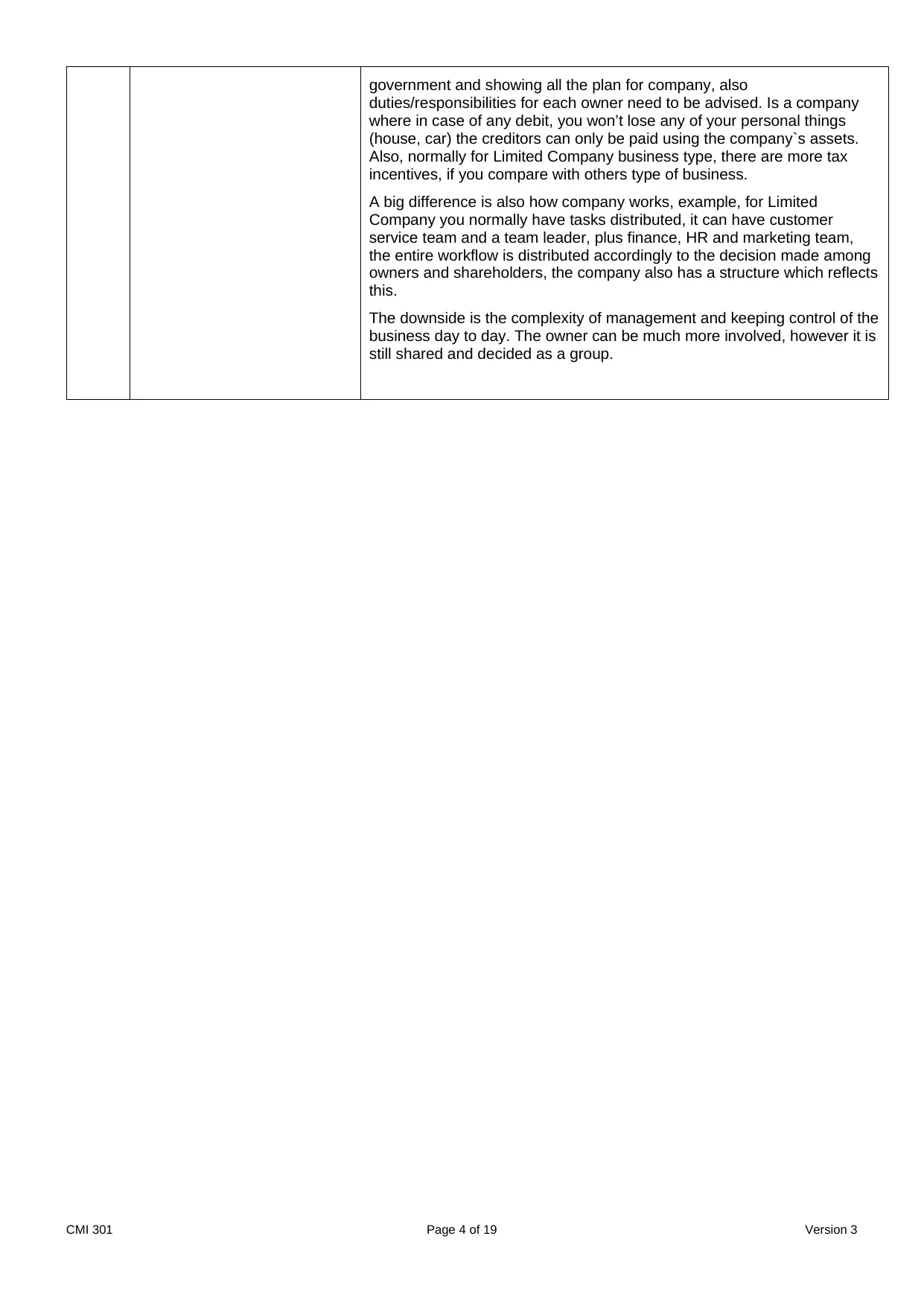
government and showing all the plan for company, also
duties/responsibilities for each owner need to be advised. Is a company
where in case of any debit, you won’t lose any of your personal things
(house, car) the creditors can only be paid using the company`s assets.
Also, normally for Limited Company business type, there are more tax
incentives, if you compare with others type of business.
A big difference is also how company works, example, for Limited
Company you normally have tasks distributed, it can have customer
service team and a team leader, plus finance, HR and marketing team,
the entire workflow is distributed accordingly to the decision made among
owners and shareholders, the company also has a structure which reflects
this.
The downside is the complexity of management and keeping control of the
business day to day. The owner can be much more involved, however it is
still shared and decided as a group.
CMI 301 Page 4 of 19 Version 3
duties/responsibilities for each owner need to be advised. Is a company
where in case of any debit, you won’t lose any of your personal things
(house, car) the creditors can only be paid using the company`s assets.
Also, normally for Limited Company business type, there are more tax
incentives, if you compare with others type of business.
A big difference is also how company works, example, for Limited
Company you normally have tasks distributed, it can have customer
service team and a team leader, plus finance, HR and marketing team,
the entire workflow is distributed accordingly to the decision made among
owners and shareholders, the company also has a structure which reflects
this.
The downside is the complexity of management and keeping control of the
business day to day. The owner can be much more involved, however it is
still shared and decided as a group.
CMI 301 Page 4 of 19 Version 3
Paraphrase This Document
Need a fresh take? Get an instant paraphrase of this document with our AI Paraphraser
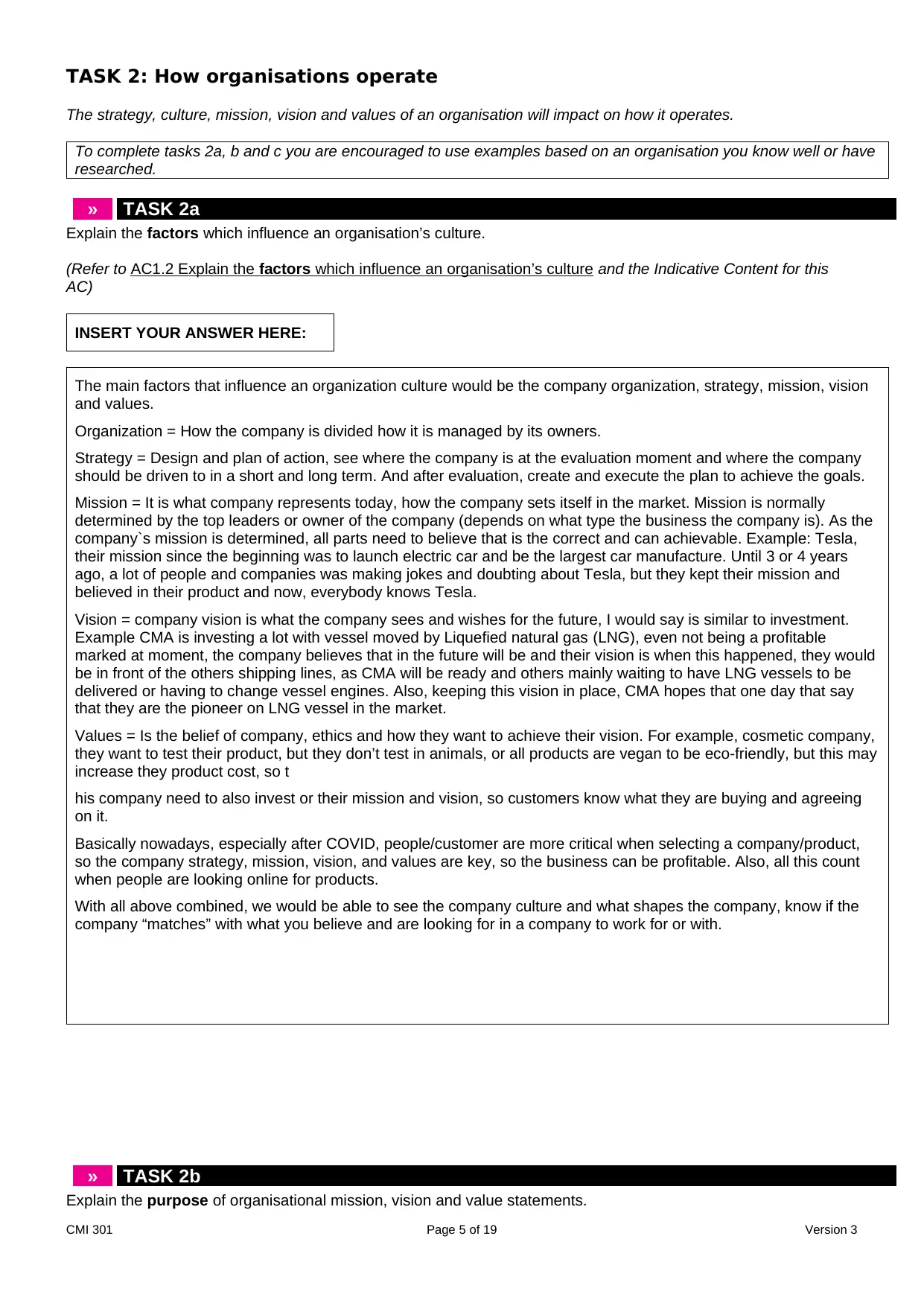
TASK 2: How organisations operate
The strategy, culture, mission, vision and values of an organisation will impact on how it operates.
To complete tasks 2a, b and c you are encouraged to use examples based on an organisation you know well or have
researched.
» TASK 2a
Explain the factors which influence an organisation’s culture.
(Refer to AC1.2 Explain the factors which influence an organisation’s culture and the Indicative Content for this
AC)
INSERT YOUR ANSWER HERE:
The main factors that influence an organization culture would be the company organization, strategy, mission, vision
and values.
Organization = How the company is divided how it is managed by its owners.
Strategy = Design and plan of action, see where the company is at the evaluation moment and where the company
should be driven to in a short and long term. And after evaluation, create and execute the plan to achieve the goals.
Mission = It is what company represents today, how the company sets itself in the market. Mission is normally
determined by the top leaders or owner of the company (depends on what type the business the company is). As the
company`s mission is determined, all parts need to believe that is the correct and can achievable. Example: Tesla,
their mission since the beginning was to launch electric car and be the largest car manufacture. Until 3 or 4 years
ago, a lot of people and companies was making jokes and doubting about Tesla, but they kept their mission and
believed in their product and now, everybody knows Tesla.
Vision = company vision is what the company sees and wishes for the future, I would say is similar to investment.
Example CMA is investing a lot with vessel moved by Liquefied natural gas (LNG), even not being a profitable
marked at moment, the company believes that in the future will be and their vision is when this happened, they would
be in front of the others shipping lines, as CMA will be ready and others mainly waiting to have LNG vessels to be
delivered or having to change vessel engines. Also, keeping this vision in place, CMA hopes that one day that say
that they are the pioneer on LNG vessel in the market.
Values = Is the belief of company, ethics and how they want to achieve their vision. For example, cosmetic company,
they want to test their product, but they don’t test in animals, or all products are vegan to be eco-friendly, but this may
increase they product cost, so t
his company need to also invest or their mission and vision, so customers know what they are buying and agreeing
on it.
Basically nowadays, especially after COVID, people/customer are more critical when selecting a company/product,
so the company strategy, mission, vision, and values are key, so the business can be profitable. Also, all this count
when people are looking online for products.
With all above combined, we would be able to see the company culture and what shapes the company, know if the
company “matches” with what you believe and are looking for in a company to work for or with.
» TASK 2b
Explain the purpose of organisational mission, vision and value statements.
CMI 301 Page 5 of 19 Version 3
The strategy, culture, mission, vision and values of an organisation will impact on how it operates.
To complete tasks 2a, b and c you are encouraged to use examples based on an organisation you know well or have
researched.
» TASK 2a
Explain the factors which influence an organisation’s culture.
(Refer to AC1.2 Explain the factors which influence an organisation’s culture and the Indicative Content for this
AC)
INSERT YOUR ANSWER HERE:
The main factors that influence an organization culture would be the company organization, strategy, mission, vision
and values.
Organization = How the company is divided how it is managed by its owners.
Strategy = Design and plan of action, see where the company is at the evaluation moment and where the company
should be driven to in a short and long term. And after evaluation, create and execute the plan to achieve the goals.
Mission = It is what company represents today, how the company sets itself in the market. Mission is normally
determined by the top leaders or owner of the company (depends on what type the business the company is). As the
company`s mission is determined, all parts need to believe that is the correct and can achievable. Example: Tesla,
their mission since the beginning was to launch electric car and be the largest car manufacture. Until 3 or 4 years
ago, a lot of people and companies was making jokes and doubting about Tesla, but they kept their mission and
believed in their product and now, everybody knows Tesla.
Vision = company vision is what the company sees and wishes for the future, I would say is similar to investment.
Example CMA is investing a lot with vessel moved by Liquefied natural gas (LNG), even not being a profitable
marked at moment, the company believes that in the future will be and their vision is when this happened, they would
be in front of the others shipping lines, as CMA will be ready and others mainly waiting to have LNG vessels to be
delivered or having to change vessel engines. Also, keeping this vision in place, CMA hopes that one day that say
that they are the pioneer on LNG vessel in the market.
Values = Is the belief of company, ethics and how they want to achieve their vision. For example, cosmetic company,
they want to test their product, but they don’t test in animals, or all products are vegan to be eco-friendly, but this may
increase they product cost, so t
his company need to also invest or their mission and vision, so customers know what they are buying and agreeing
on it.
Basically nowadays, especially after COVID, people/customer are more critical when selecting a company/product,
so the company strategy, mission, vision, and values are key, so the business can be profitable. Also, all this count
when people are looking online for products.
With all above combined, we would be able to see the company culture and what shapes the company, know if the
company “matches” with what you believe and are looking for in a company to work for or with.
» TASK 2b
Explain the purpose of organisational mission, vision and value statements.
CMI 301 Page 5 of 19 Version 3
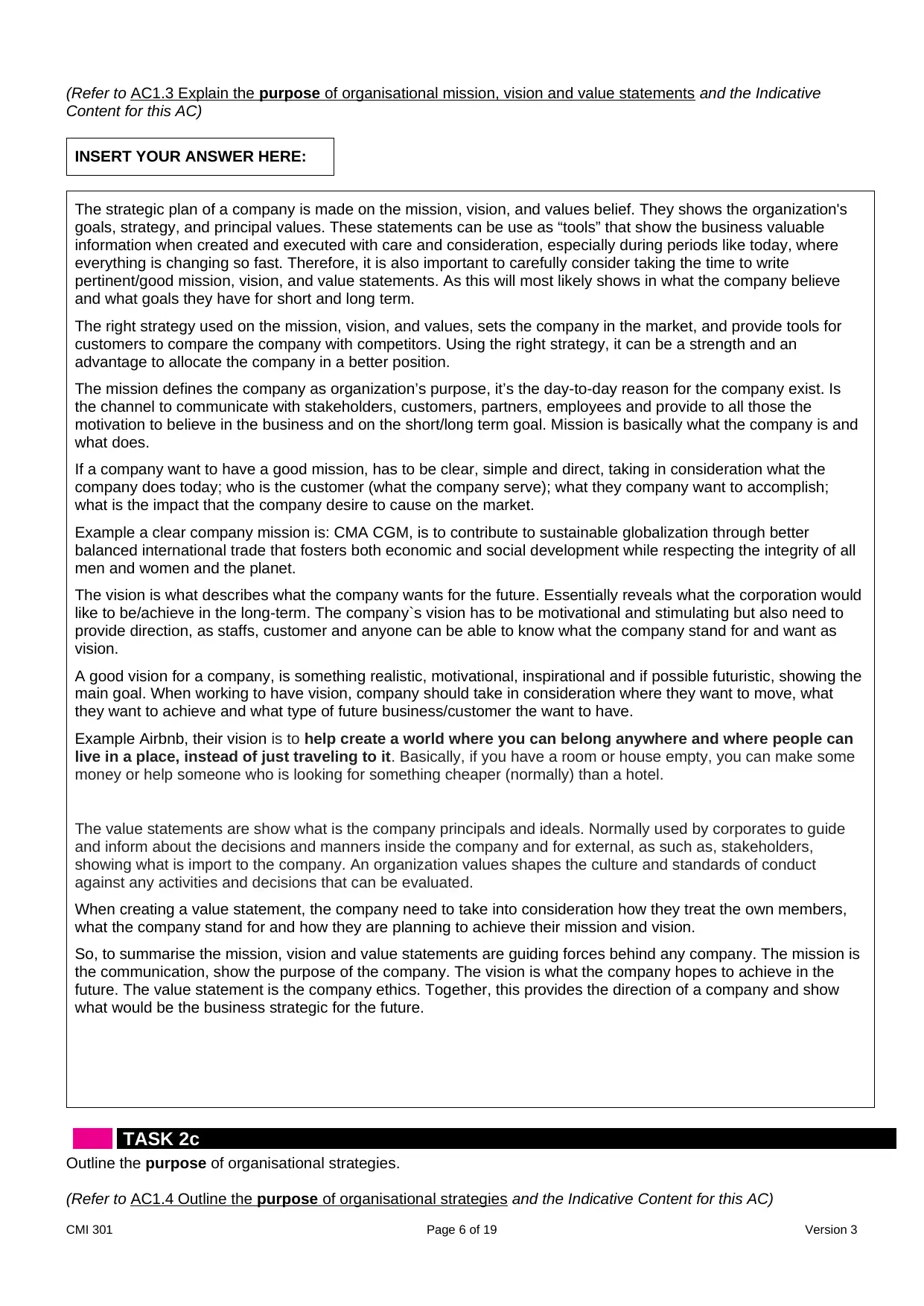
(Refer to AC1.3 Explain the purpose of organisational mission, vision and value statements and the Indicative
Content for this AC)
INSERT YOUR ANSWER HERE:
The strategic plan of a company is made on the mission, vision, and values belief. They shows the organization's
goals, strategy, and principal values. These statements can be use as “tools” that show the business valuable
information when created and executed with care and consideration, especially during periods like today, where
everything is changing so fast. Therefore, it is also important to carefully consider taking the time to write
pertinent/good mission, vision, and value statements. As this will most likely shows in what the company believe
and what goals they have for short and long term.
The right strategy used on the mission, vision, and values, sets the company in the market, and provide tools for
customers to compare the company with competitors. Using the right strategy, it can be a strength and an
advantage to allocate the company in a better position.
The mission defines the company as organization’s purpose, it’s the day-to-day reason for the company exist. Is
the channel to communicate with stakeholders, customers, partners, employees and provide to all those the
motivation to believe in the business and on the short/long term goal. Mission is basically what the company is and
what does.
If a company want to have a good mission, has to be clear, simple and direct, taking in consideration what the
company does today; who is the customer (what the company serve); what they company want to accomplish;
what is the impact that the company desire to cause on the market.
Example a clear company mission is: CMA CGM, is to contribute to sustainable globalization through better
balanced international trade that fosters both economic and social development while respecting the integrity of all
men and women and the planet.
The vision is what describes what the company wants for the future. Essentially reveals what the corporation would
like to be/achieve in the long-term. The company`s vision has to be motivational and stimulating but also need to
provide direction, as staffs, customer and anyone can be able to know what the company stand for and want as
vision.
A good vision for a company, is something realistic, motivational, inspirational and if possible futuristic, showing the
main goal. When working to have vision, company should take in consideration where they want to move, what
they want to achieve and what type of future business/customer the want to have.
Example Airbnb, their vision is to help create a world where you can belong anywhere and where people can
live in a place, instead of just traveling to it. Basically, if you have a room or house empty, you can make some
money or help someone who is looking for something cheaper (normally) than a hotel.
The value statements are show what is the company principals and ideals. Normally used by corporates to guide
and inform about the decisions and manners inside the company and for external, as such as, stakeholders,
showing what is import to the company. An organization values shapes the culture and standards of conduct
against any activities and decisions that can be evaluated.
When creating a value statement, the company need to take into consideration how they treat the own members,
what the company stand for and how they are planning to achieve their mission and vision.
So, to summarise the mission, vision and value statements are guiding forces behind any company. The mission is
the communication, show the purpose of the company. The vision is what the company hopes to achieve in the
future. The value statement is the company ethics. Together, this provides the direction of a company and show
what would be the business strategic for the future.
TASK 2c
Outline the purpose of organisational strategies.
(Refer to AC1.4 Outline the purpose of organisational strategies and the Indicative Content for this AC)
CMI 301 Page 6 of 19 Version 3
Content for this AC)
INSERT YOUR ANSWER HERE:
The strategic plan of a company is made on the mission, vision, and values belief. They shows the organization's
goals, strategy, and principal values. These statements can be use as “tools” that show the business valuable
information when created and executed with care and consideration, especially during periods like today, where
everything is changing so fast. Therefore, it is also important to carefully consider taking the time to write
pertinent/good mission, vision, and value statements. As this will most likely shows in what the company believe
and what goals they have for short and long term.
The right strategy used on the mission, vision, and values, sets the company in the market, and provide tools for
customers to compare the company with competitors. Using the right strategy, it can be a strength and an
advantage to allocate the company in a better position.
The mission defines the company as organization’s purpose, it’s the day-to-day reason for the company exist. Is
the channel to communicate with stakeholders, customers, partners, employees and provide to all those the
motivation to believe in the business and on the short/long term goal. Mission is basically what the company is and
what does.
If a company want to have a good mission, has to be clear, simple and direct, taking in consideration what the
company does today; who is the customer (what the company serve); what they company want to accomplish;
what is the impact that the company desire to cause on the market.
Example a clear company mission is: CMA CGM, is to contribute to sustainable globalization through better
balanced international trade that fosters both economic and social development while respecting the integrity of all
men and women and the planet.
The vision is what describes what the company wants for the future. Essentially reveals what the corporation would
like to be/achieve in the long-term. The company`s vision has to be motivational and stimulating but also need to
provide direction, as staffs, customer and anyone can be able to know what the company stand for and want as
vision.
A good vision for a company, is something realistic, motivational, inspirational and if possible futuristic, showing the
main goal. When working to have vision, company should take in consideration where they want to move, what
they want to achieve and what type of future business/customer the want to have.
Example Airbnb, their vision is to help create a world where you can belong anywhere and where people can
live in a place, instead of just traveling to it. Basically, if you have a room or house empty, you can make some
money or help someone who is looking for something cheaper (normally) than a hotel.
The value statements are show what is the company principals and ideals. Normally used by corporates to guide
and inform about the decisions and manners inside the company and for external, as such as, stakeholders,
showing what is import to the company. An organization values shapes the culture and standards of conduct
against any activities and decisions that can be evaluated.
When creating a value statement, the company need to take into consideration how they treat the own members,
what the company stand for and how they are planning to achieve their mission and vision.
So, to summarise the mission, vision and value statements are guiding forces behind any company. The mission is
the communication, show the purpose of the company. The vision is what the company hopes to achieve in the
future. The value statement is the company ethics. Together, this provides the direction of a company and show
what would be the business strategic for the future.
TASK 2c
Outline the purpose of organisational strategies.
(Refer to AC1.4 Outline the purpose of organisational strategies and the Indicative Content for this AC)
CMI 301 Page 6 of 19 Version 3
⊘ This is a preview!⊘
Do you want full access?
Subscribe today to unlock all pages.

Trusted by 1+ million students worldwide
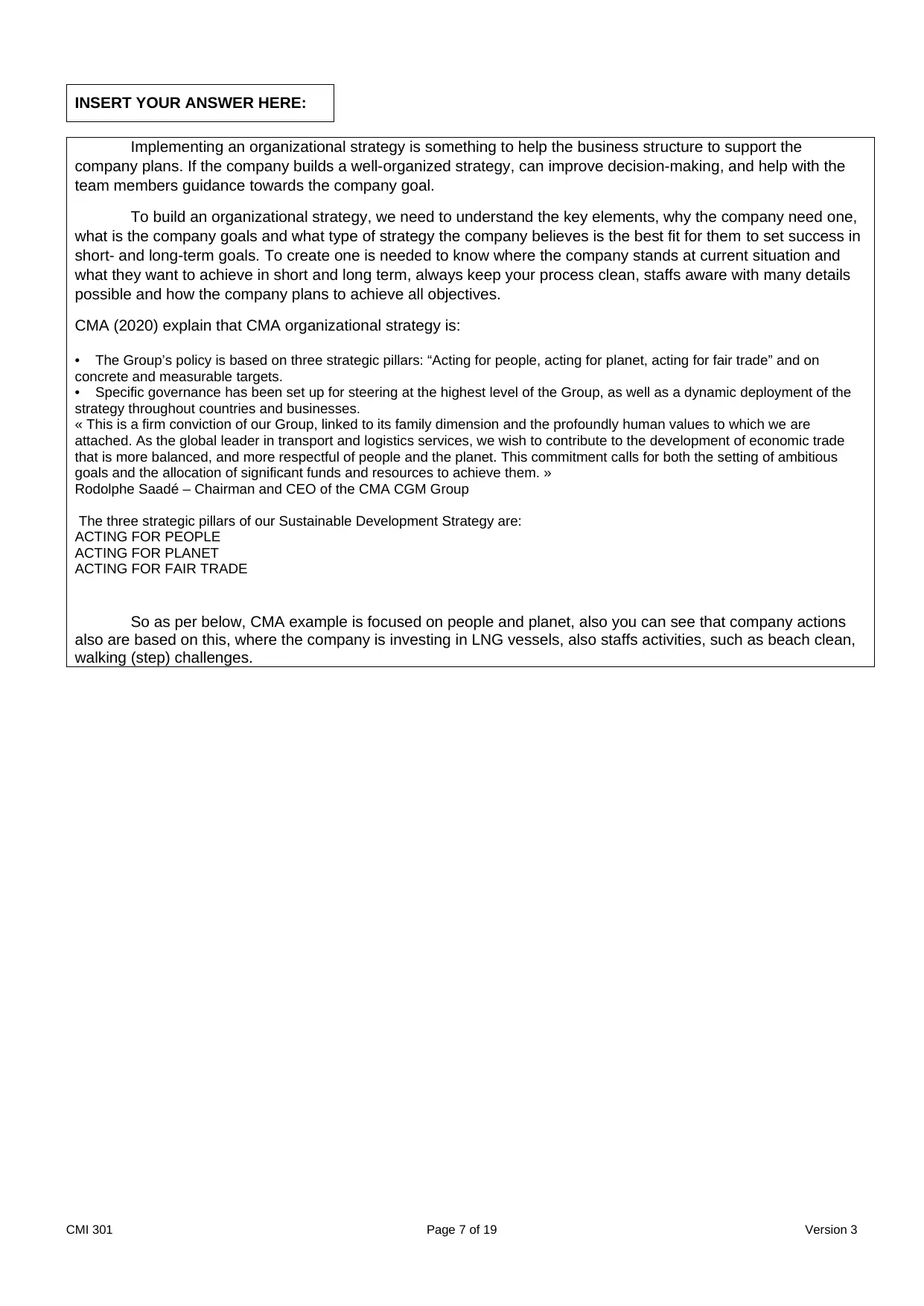
INSERT YOUR ANSWER HERE:
Implementing an organizational strategy is something to help the business structure to support the
company plans. If the company builds a well-organized strategy, can improve decision-making, and help with the
team members guidance towards the company goal.
To build an organizational strategy, we need to understand the key elements, why the company need one,
what is the company goals and what type of strategy the company believes is the best fit for them to set success in
short- and long-term goals. To create one is needed to know where the company stands at current situation and
what they want to achieve in short and long term, always keep your process clean, staffs aware with many details
possible and how the company plans to achieve all objectives.
CMA (2020) explain that CMA organizational strategy is:
• The Group’s policy is based on three strategic pillars: “Acting for people, acting for planet, acting for fair trade” and on
concrete and measurable targets.
• Specific governance has been set up for steering at the highest level of the Group, as well as a dynamic deployment of the
strategy throughout countries and businesses.
« This is a firm conviction of our Group, linked to its family dimension and the profoundly human values to which we are
attached. As the global leader in transport and logistics services, we wish to contribute to the development of economic trade
that is more balanced, and more respectful of people and the planet. This commitment calls for both the setting of ambitious
goals and the allocation of significant funds and resources to achieve them. »
Rodolphe Saadé – Chairman and CEO of the CMA CGM Group
The three strategic pillars of our Sustainable Development Strategy are:
ACTING FOR PEOPLE
ACTING FOR PLANET
ACTING FOR FAIR TRADE
So as per below, CMA example is focused on people and planet, also you can see that company actions
also are based on this, where the company is investing in LNG vessels, also staffs activities, such as beach clean,
walking (step) challenges.
CMI 301 Page 7 of 19 Version 3
Implementing an organizational strategy is something to help the business structure to support the
company plans. If the company builds a well-organized strategy, can improve decision-making, and help with the
team members guidance towards the company goal.
To build an organizational strategy, we need to understand the key elements, why the company need one,
what is the company goals and what type of strategy the company believes is the best fit for them to set success in
short- and long-term goals. To create one is needed to know where the company stands at current situation and
what they want to achieve in short and long term, always keep your process clean, staffs aware with many details
possible and how the company plans to achieve all objectives.
CMA (2020) explain that CMA organizational strategy is:
• The Group’s policy is based on three strategic pillars: “Acting for people, acting for planet, acting for fair trade” and on
concrete and measurable targets.
• Specific governance has been set up for steering at the highest level of the Group, as well as a dynamic deployment of the
strategy throughout countries and businesses.
« This is a firm conviction of our Group, linked to its family dimension and the profoundly human values to which we are
attached. As the global leader in transport and logistics services, we wish to contribute to the development of economic trade
that is more balanced, and more respectful of people and the planet. This commitment calls for both the setting of ambitious
goals and the allocation of significant funds and resources to achieve them. »
Rodolphe Saadé – Chairman and CEO of the CMA CGM Group
The three strategic pillars of our Sustainable Development Strategy are:
ACTING FOR PEOPLE
ACTING FOR PLANET
ACTING FOR FAIR TRADE
So as per below, CMA example is focused on people and planet, also you can see that company actions
also are based on this, where the company is investing in LNG vessels, also staffs activities, such as beach clean,
walking (step) challenges.
CMI 301 Page 7 of 19 Version 3
Paraphrase This Document
Need a fresh take? Get an instant paraphrase of this document with our AI Paraphraser
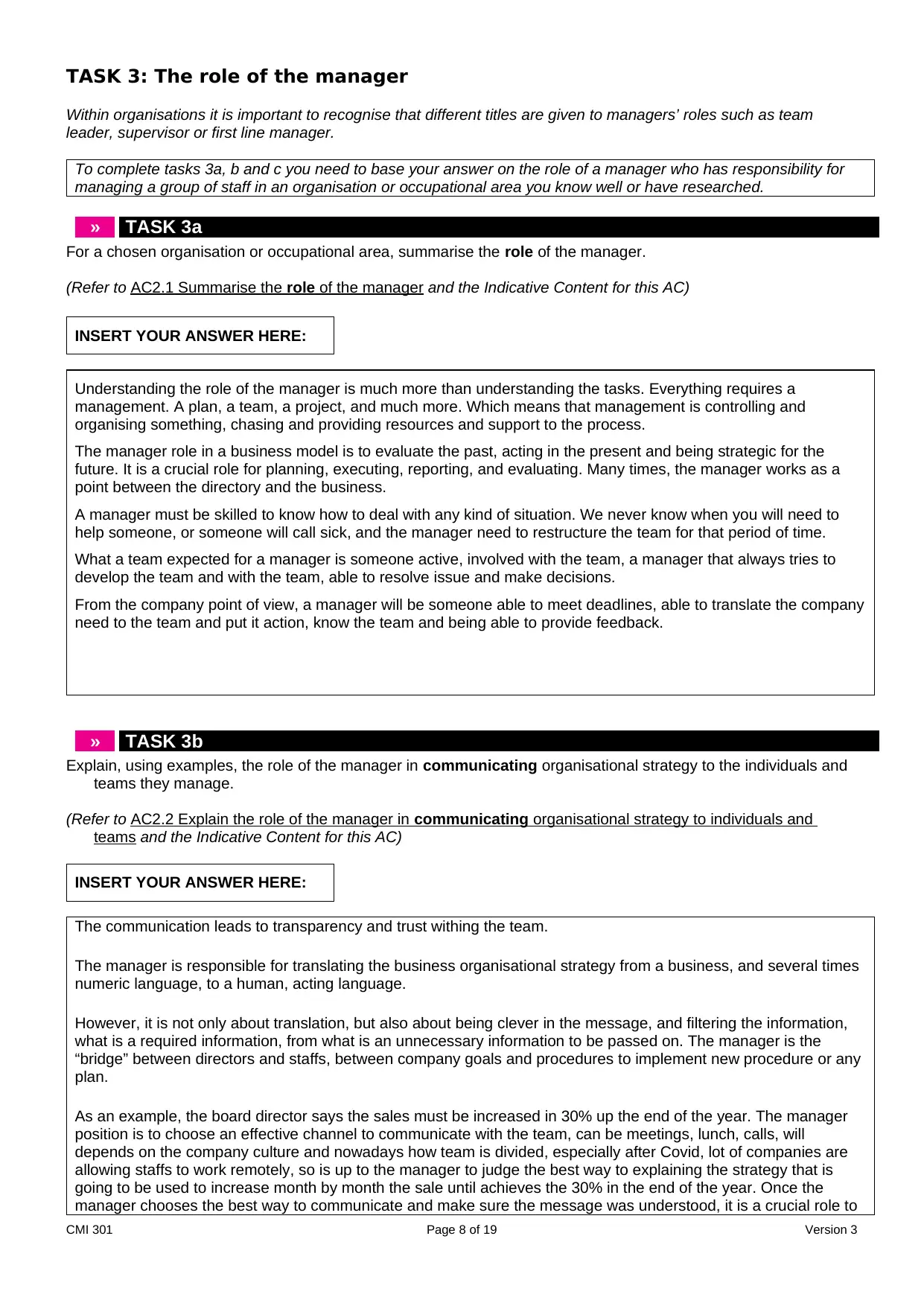
TASK 3: The role of the manager
Within organisations it is important to recognise that different titles are given to managers’ roles such as team
leader, supervisor or first line manager.
To complete tasks 3a, b and c you need to base your answer on the role of a manager who has responsibility for
managing a group of staff in an organisation or occupational area you know well or have researched.
» TASK 3a
For a chosen organisation or occupational area, summarise the role of the manager.
(Refer to AC2.1 Summarise the role of the manager and the Indicative Content for this AC)
INSERT YOUR ANSWER HERE:
Understanding the role of the manager is much more than understanding the tasks. Everything requires a
management. A plan, a team, a project, and much more. Which means that management is controlling and
organising something, chasing and providing resources and support to the process.
The manager role in a business model is to evaluate the past, acting in the present and being strategic for the
future. It is a crucial role for planning, executing, reporting, and evaluating. Many times, the manager works as a
point between the directory and the business.
A manager must be skilled to know how to deal with any kind of situation. We never know when you will need to
help someone, or someone will call sick, and the manager need to restructure the team for that period of time.
What a team expected for a manager is someone active, involved with the team, a manager that always tries to
develop the team and with the team, able to resolve issue and make decisions.
From the company point of view, a manager will be someone able to meet deadlines, able to translate the company
need to the team and put it action, know the team and being able to provide feedback.
» TASK 3b
Explain, using examples, the role of the manager in communicating organisational strategy to the individuals and
teams they manage.
(Refer to AC2.2 Explain the role of the manager in communicating organisational strategy to individuals and
teams and the Indicative Content for this AC)
INSERT YOUR ANSWER HERE:
The communication leads to transparency and trust withing the team.
The manager is responsible for translating the business organisational strategy from a business, and several times
numeric language, to a human, acting language.
However, it is not only about translation, but also about being clever in the message, and filtering the information,
what is a required information, from what is an unnecessary information to be passed on. The manager is the
“bridge” between directors and staffs, between company goals and procedures to implement new procedure or any
plan.
As an example, the board director says the sales must be increased in 30% up the end of the year. The manager
position is to choose an effective channel to communicate with the team, can be meetings, lunch, calls, will
depends on the company culture and nowadays how team is divided, especially after Covid, lot of companies are
allowing staffs to work remotely, so is up to the manager to judge the best way to explaining the strategy that is
going to be used to increase month by month the sale until achieves the 30% in the end of the year. Once the
manager chooses the best way to communicate and make sure the message was understood, it is a crucial role to
CMI 301 Page 8 of 19 Version 3
Within organisations it is important to recognise that different titles are given to managers’ roles such as team
leader, supervisor or first line manager.
To complete tasks 3a, b and c you need to base your answer on the role of a manager who has responsibility for
managing a group of staff in an organisation or occupational area you know well or have researched.
» TASK 3a
For a chosen organisation or occupational area, summarise the role of the manager.
(Refer to AC2.1 Summarise the role of the manager and the Indicative Content for this AC)
INSERT YOUR ANSWER HERE:
Understanding the role of the manager is much more than understanding the tasks. Everything requires a
management. A plan, a team, a project, and much more. Which means that management is controlling and
organising something, chasing and providing resources and support to the process.
The manager role in a business model is to evaluate the past, acting in the present and being strategic for the
future. It is a crucial role for planning, executing, reporting, and evaluating. Many times, the manager works as a
point between the directory and the business.
A manager must be skilled to know how to deal with any kind of situation. We never know when you will need to
help someone, or someone will call sick, and the manager need to restructure the team for that period of time.
What a team expected for a manager is someone active, involved with the team, a manager that always tries to
develop the team and with the team, able to resolve issue and make decisions.
From the company point of view, a manager will be someone able to meet deadlines, able to translate the company
need to the team and put it action, know the team and being able to provide feedback.
» TASK 3b
Explain, using examples, the role of the manager in communicating organisational strategy to the individuals and
teams they manage.
(Refer to AC2.2 Explain the role of the manager in communicating organisational strategy to individuals and
teams and the Indicative Content for this AC)
INSERT YOUR ANSWER HERE:
The communication leads to transparency and trust withing the team.
The manager is responsible for translating the business organisational strategy from a business, and several times
numeric language, to a human, acting language.
However, it is not only about translation, but also about being clever in the message, and filtering the information,
what is a required information, from what is an unnecessary information to be passed on. The manager is the
“bridge” between directors and staffs, between company goals and procedures to implement new procedure or any
plan.
As an example, the board director says the sales must be increased in 30% up the end of the year. The manager
position is to choose an effective channel to communicate with the team, can be meetings, lunch, calls, will
depends on the company culture and nowadays how team is divided, especially after Covid, lot of companies are
allowing staffs to work remotely, so is up to the manager to judge the best way to explaining the strategy that is
going to be used to increase month by month the sale until achieves the 30% in the end of the year. Once the
manager chooses the best way to communicate and make sure the message was understood, it is a crucial role to
CMI 301 Page 8 of 19 Version 3
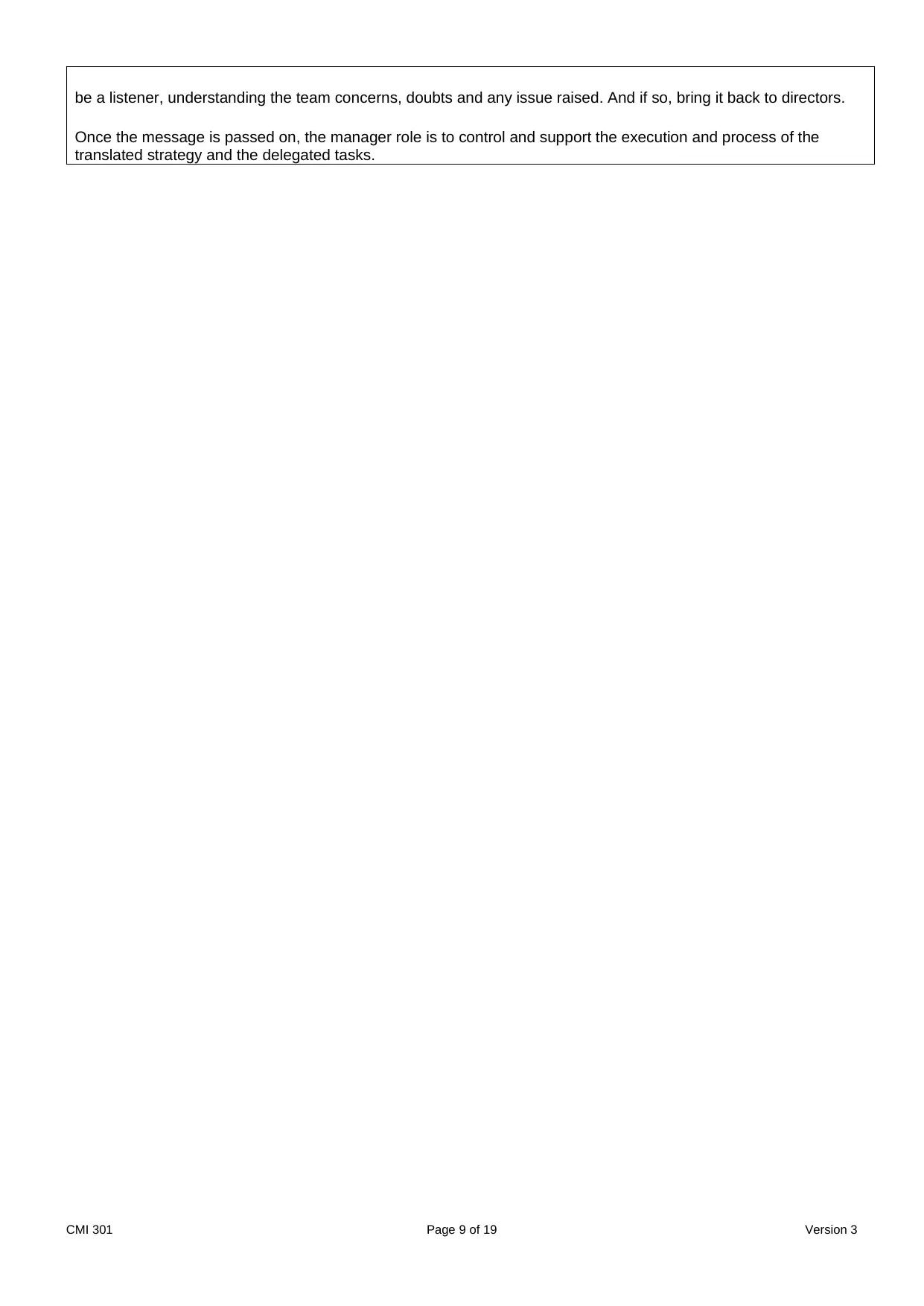
be a listener, understanding the team concerns, doubts and any issue raised. And if so, bring it back to directors.
Once the message is passed on, the manager role is to control and support the execution and process of the
translated strategy and the delegated tasks.
CMI 301 Page 9 of 19 Version 3
Once the message is passed on, the manager role is to control and support the execution and process of the
translated strategy and the delegated tasks.
CMI 301 Page 9 of 19 Version 3
⊘ This is a preview!⊘
Do you want full access?
Subscribe today to unlock all pages.

Trusted by 1+ million students worldwide
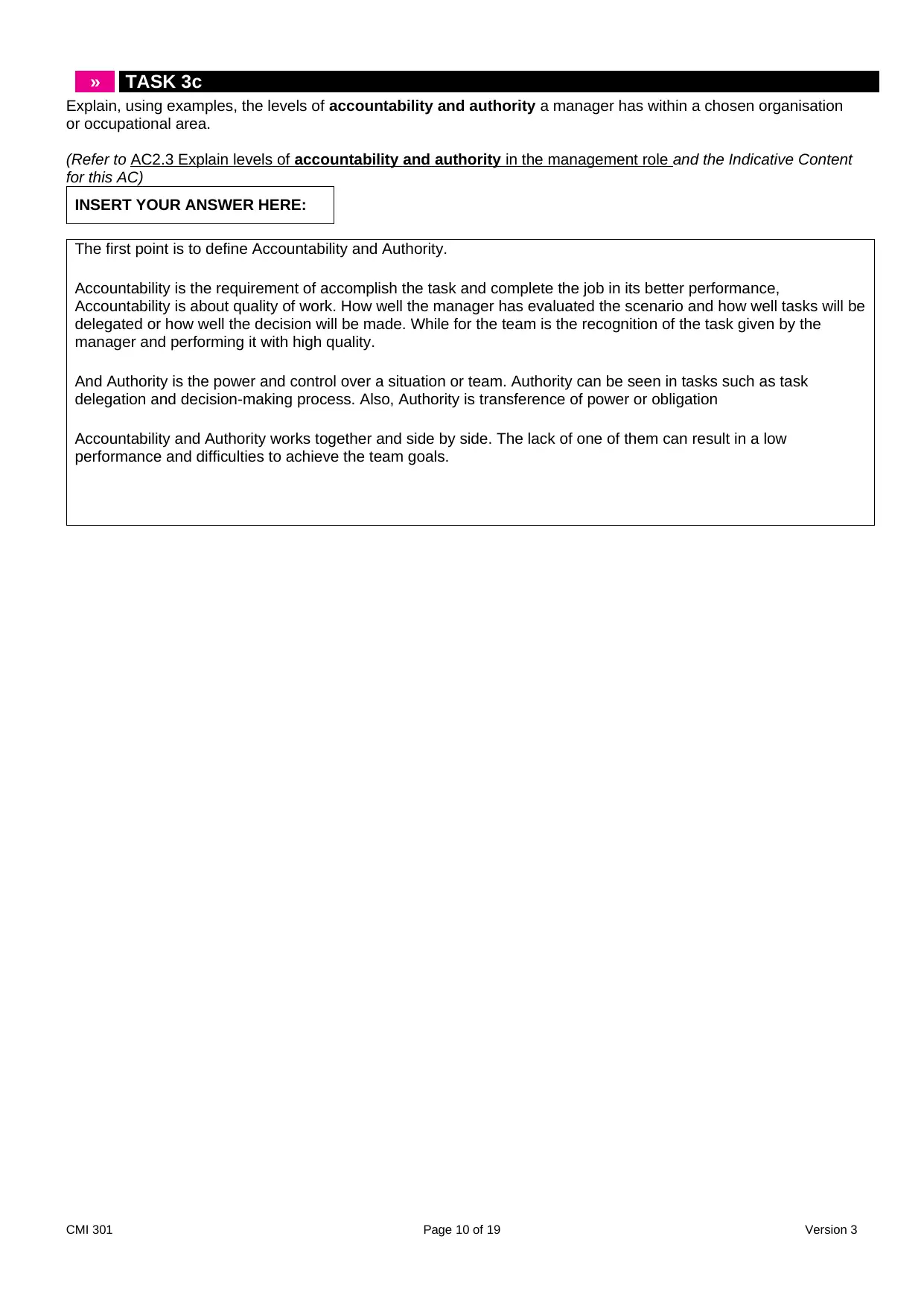
» TASK 3c
Explain, using examples, the levels of accountability and authority a manager has within a chosen organisation
or occupational area.
(Refer to AC2.3 Explain levels of accountability and authority in the management role and the Indicative Content
for this AC)
INSERT YOUR ANSWER HERE:
The first point is to define Accountability and Authority.
Accountability is the requirement of accomplish the task and complete the job in its better performance,
Accountability is about quality of work. How well the manager has evaluated the scenario and how well tasks will be
delegated or how well the decision will be made. While for the team is the recognition of the task given by the
manager and performing it with high quality.
And Authority is the power and control over a situation or team. Authority can be seen in tasks such as task
delegation and decision-making process. Also, Authority is transference of power or obligation
Accountability and Authority works together and side by side. The lack of one of them can result in a low
performance and difficulties to achieve the team goals.
CMI 301 Page 10 of 19 Version 3
Explain, using examples, the levels of accountability and authority a manager has within a chosen organisation
or occupational area.
(Refer to AC2.3 Explain levels of accountability and authority in the management role and the Indicative Content
for this AC)
INSERT YOUR ANSWER HERE:
The first point is to define Accountability and Authority.
Accountability is the requirement of accomplish the task and complete the job in its better performance,
Accountability is about quality of work. How well the manager has evaluated the scenario and how well tasks will be
delegated or how well the decision will be made. While for the team is the recognition of the task given by the
manager and performing it with high quality.
And Authority is the power and control over a situation or team. Authority can be seen in tasks such as task
delegation and decision-making process. Also, Authority is transference of power or obligation
Accountability and Authority works together and side by side. The lack of one of them can result in a low
performance and difficulties to achieve the team goals.
CMI 301 Page 10 of 19 Version 3
Paraphrase This Document
Need a fresh take? Get an instant paraphrase of this document with our AI Paraphraser
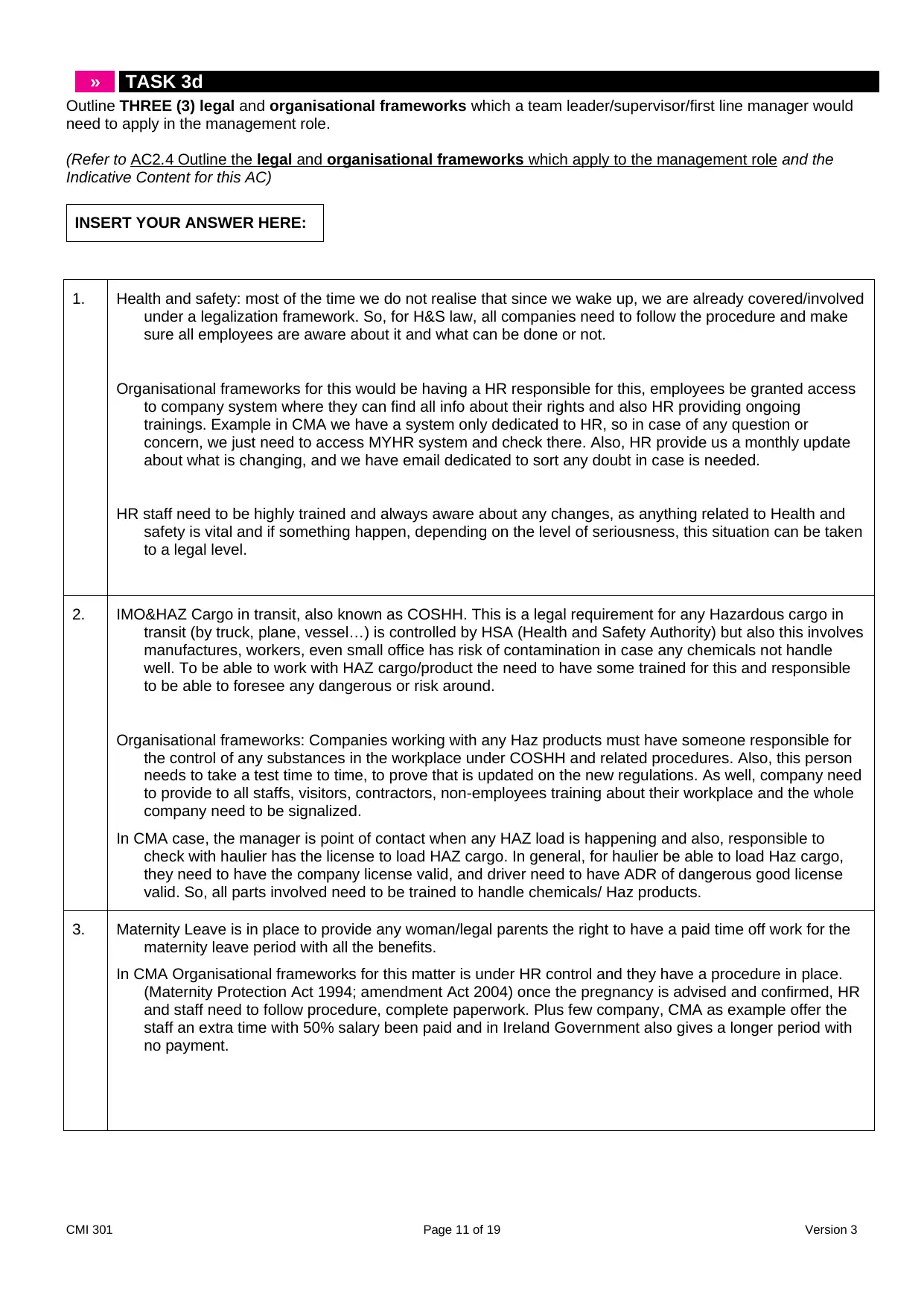
» TASK 3d
Outline THREE (3) legal and organisational frameworks which a team leader/supervisor/first line manager would
need to apply in the management role.
(Refer to AC2.4 Outline the legal and organisational frameworks which apply to the management role and the
Indicative Content for this AC)
INSERT YOUR ANSWER HERE:
1. Health and safety: most of the time we do not realise that since we wake up, we are already covered/involved
under a legalization framework. So, for H&S law, all companies need to follow the procedure and make
sure all employees are aware about it and what can be done or not.
Organisational frameworks for this would be having a HR responsible for this, employees be granted access
to company system where they can find all info about their rights and also HR providing ongoing
trainings. Example in CMA we have a system only dedicated to HR, so in case of any question or
concern, we just need to access MYHR system and check there. Also, HR provide us a monthly update
about what is changing, and we have email dedicated to sort any doubt in case is needed.
HR staff need to be highly trained and always aware about any changes, as anything related to Health and
safety is vital and if something happen, depending on the level of seriousness, this situation can be taken
to a legal level.
2. IMO&HAZ Cargo in transit, also known as COSHH. This is a legal requirement for any Hazardous cargo in
transit (by truck, plane, vessel…) is controlled by HSA (Health and Safety Authority) but also this involves
manufactures, workers, even small office has risk of contamination in case any chemicals not handle
well. To be able to work with HAZ cargo/product the need to have some trained for this and responsible
to be able to foresee any dangerous or risk around.
Organisational frameworks: Companies working with any Haz products must have someone responsible for
the control of any substances in the workplace under COSHH and related procedures. Also, this person
needs to take a test time to time, to prove that is updated on the new regulations. As well, company need
to provide to all staffs, visitors, contractors, non-employees training about their workplace and the whole
company need to be signalized.
In CMA case, the manager is point of contact when any HAZ load is happening and also, responsible to
check with haulier has the license to load HAZ cargo. In general, for haulier be able to load Haz cargo,
they need to have the company license valid, and driver need to have ADR of dangerous good license
valid. So, all parts involved need to be trained to handle chemicals/ Haz products.
3. Maternity Leave is in place to provide any woman/legal parents the right to have a paid time off work for the
maternity leave period with all the benefits.
In CMA Organisational frameworks for this matter is under HR control and they have a procedure in place.
(Maternity Protection Act 1994; amendment Act 2004) once the pregnancy is advised and confirmed, HR
and staff need to follow procedure, complete paperwork. Plus few company, CMA as example offer the
staff an extra time with 50% salary been paid and in Ireland Government also gives a longer period with
no payment.
CMI 301 Page 11 of 19 Version 3
Outline THREE (3) legal and organisational frameworks which a team leader/supervisor/first line manager would
need to apply in the management role.
(Refer to AC2.4 Outline the legal and organisational frameworks which apply to the management role and the
Indicative Content for this AC)
INSERT YOUR ANSWER HERE:
1. Health and safety: most of the time we do not realise that since we wake up, we are already covered/involved
under a legalization framework. So, for H&S law, all companies need to follow the procedure and make
sure all employees are aware about it and what can be done or not.
Organisational frameworks for this would be having a HR responsible for this, employees be granted access
to company system where they can find all info about their rights and also HR providing ongoing
trainings. Example in CMA we have a system only dedicated to HR, so in case of any question or
concern, we just need to access MYHR system and check there. Also, HR provide us a monthly update
about what is changing, and we have email dedicated to sort any doubt in case is needed.
HR staff need to be highly trained and always aware about any changes, as anything related to Health and
safety is vital and if something happen, depending on the level of seriousness, this situation can be taken
to a legal level.
2. IMO&HAZ Cargo in transit, also known as COSHH. This is a legal requirement for any Hazardous cargo in
transit (by truck, plane, vessel…) is controlled by HSA (Health and Safety Authority) but also this involves
manufactures, workers, even small office has risk of contamination in case any chemicals not handle
well. To be able to work with HAZ cargo/product the need to have some trained for this and responsible
to be able to foresee any dangerous or risk around.
Organisational frameworks: Companies working with any Haz products must have someone responsible for
the control of any substances in the workplace under COSHH and related procedures. Also, this person
needs to take a test time to time, to prove that is updated on the new regulations. As well, company need
to provide to all staffs, visitors, contractors, non-employees training about their workplace and the whole
company need to be signalized.
In CMA case, the manager is point of contact when any HAZ load is happening and also, responsible to
check with haulier has the license to load HAZ cargo. In general, for haulier be able to load Haz cargo,
they need to have the company license valid, and driver need to have ADR of dangerous good license
valid. So, all parts involved need to be trained to handle chemicals/ Haz products.
3. Maternity Leave is in place to provide any woman/legal parents the right to have a paid time off work for the
maternity leave period with all the benefits.
In CMA Organisational frameworks for this matter is under HR control and they have a procedure in place.
(Maternity Protection Act 1994; amendment Act 2004) once the pregnancy is advised and confirmed, HR
and staff need to follow procedure, complete paperwork. Plus few company, CMA as example offer the
staff an extra time with 50% salary been paid and in Ireland Government also gives a longer period with
no payment.
CMI 301 Page 11 of 19 Version 3
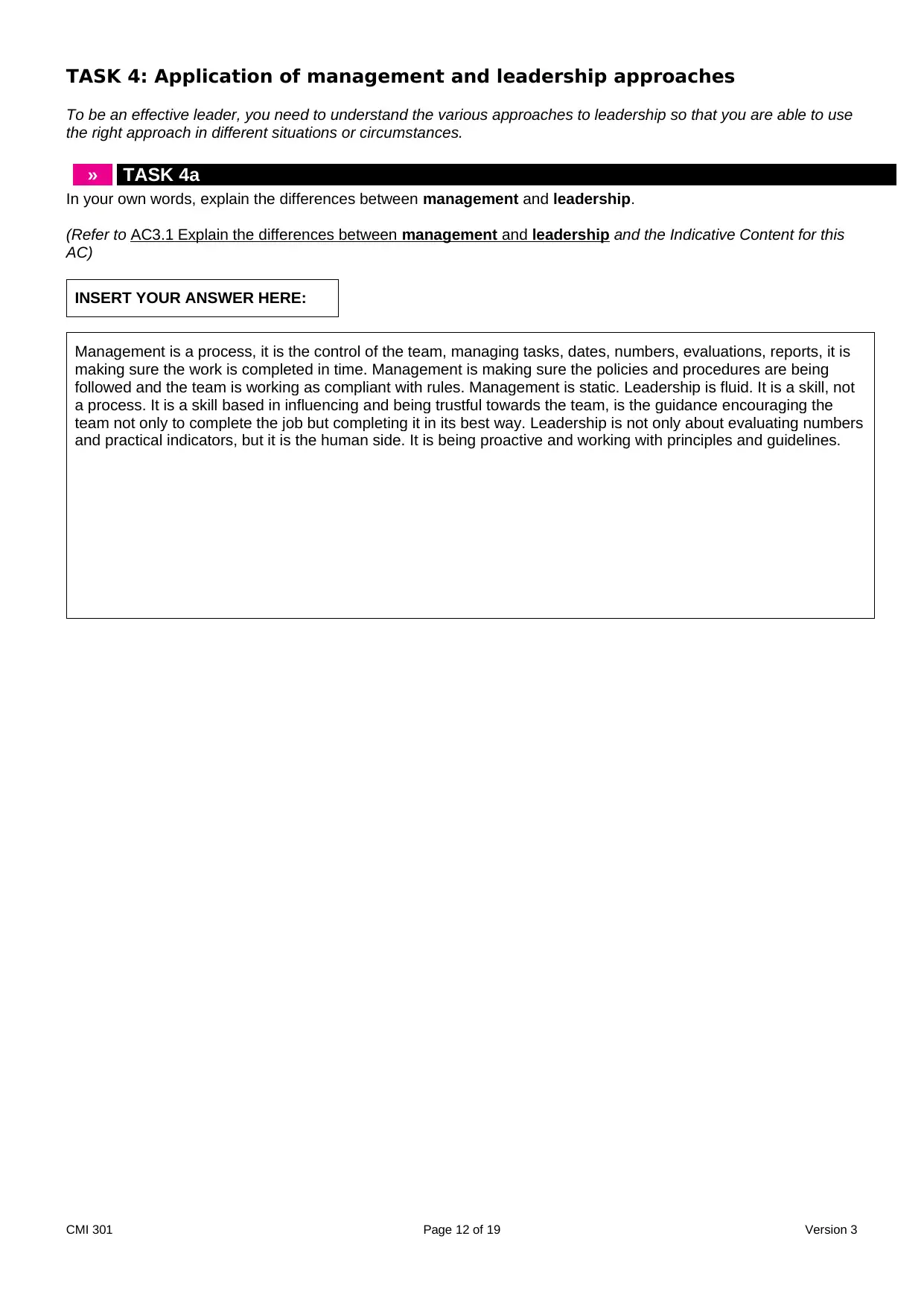
TASK 4: Application of management and leadership approaches
To be an effective leader, you need to understand the various approaches to leadership so that you are able to use
the right approach in different situations or circumstances.
» TASK 4a
In your own words, explain the differences between management and leadership.
(Refer to AC3.1 Explain the differences between management and leadership and the Indicative Content for this
AC)
INSERT YOUR ANSWER HERE:
Management is a process, it is the control of the team, managing tasks, dates, numbers, evaluations, reports, it is
making sure the work is completed in time. Management is making sure the policies and procedures are being
followed and the team is working as compliant with rules. Management is static. Leadership is fluid. It is a skill, not
a process. It is a skill based in influencing and being trustful towards the team, is the guidance encouraging the
team not only to complete the job but completing it in its best way. Leadership is not only about evaluating numbers
and practical indicators, but it is the human side. It is being proactive and working with principles and guidelines.
CMI 301 Page 12 of 19 Version 3
To be an effective leader, you need to understand the various approaches to leadership so that you are able to use
the right approach in different situations or circumstances.
» TASK 4a
In your own words, explain the differences between management and leadership.
(Refer to AC3.1 Explain the differences between management and leadership and the Indicative Content for this
AC)
INSERT YOUR ANSWER HERE:
Management is a process, it is the control of the team, managing tasks, dates, numbers, evaluations, reports, it is
making sure the work is completed in time. Management is making sure the policies and procedures are being
followed and the team is working as compliant with rules. Management is static. Leadership is fluid. It is a skill, not
a process. It is a skill based in influencing and being trustful towards the team, is the guidance encouraging the
team not only to complete the job but completing it in its best way. Leadership is not only about evaluating numbers
and practical indicators, but it is the human side. It is being proactive and working with principles and guidelines.
CMI 301 Page 12 of 19 Version 3
⊘ This is a preview!⊘
Do you want full access?
Subscribe today to unlock all pages.

Trusted by 1+ million students worldwide
1 out of 19
Related Documents
Your All-in-One AI-Powered Toolkit for Academic Success.
+13062052269
info@desklib.com
Available 24*7 on WhatsApp / Email
![[object Object]](/_next/static/media/star-bottom.7253800d.svg)
Unlock your academic potential
Copyright © 2020–2025 A2Z Services. All Rights Reserved. Developed and managed by ZUCOL.





